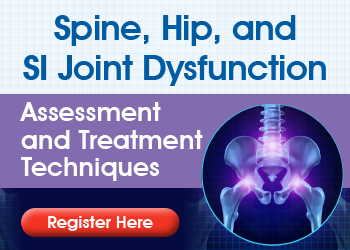Course Outline
Screen, Steer, Move: Quickly Identify and Correct Faulty Movement Patterns
Mitch Hauschildt, MA, ATC, CSCS |
The key to improving movement quality starts with a high-quality screening tool. NCAA athletic trainer Mitch Hauschildt will provide insight for how to screen and enhance movement quality with this step-by-step process. As a result, you will have improved clinical outcomes and increased performance in your patient population even with your most difficult to break movement patterns!
Hip Impingement: Assessment and Treatment
Adam Wolf, PT, LMT, FAFS |
When you can integrate the musculoskeletal, nervous and vestibular systems – you've got the treatment trifecta for assessing and treating hip impingement. You’ll learn new approaches to:
- Integrate systems for assessment and load movement applications
- Feel confident knowing when to stabilize vs when to mobilize
- Better assess the nervous system as a part of your protocol with a motor control perspective
Thoracic Spine: Assessment and Treatment
Adam Wolf, PT, LMT, FAFS |
The thoracic spine region can be quite a challenge to assess, much less treat, leaving your patients complaining of neck pain, shoulder pain, lower back pain, respiratory deficiencies, and posture and position problems. This module will provide:
- Specific techniques to enhance motion, mobility & stability of the thoracic spine
- Implement loaded movement concepts to enhance and preserve both type 1 & 2 thoracic spine motion
- New ideas for integrated movement treatment, motor control, and intervention strategies
Preventing Sacroiliac Joint Pain: It’s All About the Hips
Jon Mulholland, DC, CCSP, CSCS |
To unlock the secrets of quickly addressing unresolved sacroiliac joint pain, you need a step-by-step approach that incorporates the whole system. Join Dr. Mullholland to learn:
- Thoracic spine and hip mobility drills to improve function
- Core strengthening exercises to help prevent SI joint pain
- Better assess the nervous system as a part of your protocol with a motor control perspective
Best of all – learn how to teach your patients the ONE movement they need to master to prevent lower back pain!

